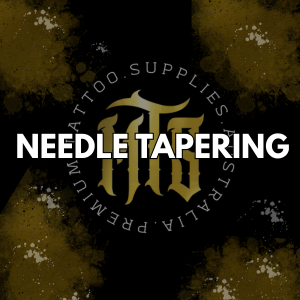Understanding Needle Taper Sizes: A Guide for Tattoo Artists
Choosing the right tattoo needle is crucial for achieving the desired results, and one of the often-overlooked aspects is needle taper size. Taper refers to the length and angle of the needle’s point, and it can significantly affect how ink is deposited into the skin. In this article, we'll explore needle taper sizes, their importance, and how they can influence your tattooing technique.
What is Needle Taper?
The taper of a needle is the length of the pointed tip leading up to the base of the needle. It essentially determines how much of the needle is sharpened and how smoothly the needle enters the skin. There are two main types of taper:
1. Short Taper
2. Long Taper

Short Taper
A short taper means that the needle's point is shorter and less gradually tapered, resulting in a sharper tip.
- USES:
- Lining: Short taper needles are often favored for outlining because they create crisp, defined lines. The sharp point allows for precise entry into the skin.
- Saturation: Due to the sharper point, these needles can deposit ink more aggressively, making them ideal for bold designs.
- Best For: Artists who focus on traditional styles, bold lettering, or any design requiring a clear, defined edge.
Long Taper
A long taper features a more extended, gradual point. This taper provides a smoother entry into the skin, which can result in less trauma.
- USES:
- Shading and Color Packing: Long taper needles are generally better suited for shading and coloring. The gradual entry allows for smoother ink flow and softer edges.
- Less Trauma: Because they enter the skin more gently, they can reduce irritation and promote better healing for the client.
- Best For: Artists specializing in realism, portrait work, or any design that requires smooth gradients and softer transitions.
Choosing the Right Taper for Your Work
1. Assess Your Style: Consider the type of tattoos you primarily create. If you focus on bold lines and outlines, short taper needles might be your go-to. For softer shading, long taper needles could be more effective.
2. Experiment: Don’t hesitate to try both types of taper in your work. Each artist has a unique style, and finding the right needle taper can complement your technique.
3. Client Comfort: Remember that the type of taper can also affect client comfort. Long taper needles may be less painful during the tattooing process, leading to a better overall experience.
4. Ink Type: Consider the type of ink you’re using as well. Some inks may perform better with one taper type over the other, affecting how smoothly they flow and settle into the skin.
Conclusion
Understanding needle taper sizes is an essential part of mastering the art of tattooing. By knowing the differences between short and long taper needles and how they impact your work, you can make more informed choices that enhance your technique and client satisfaction. As you continue to develop your skills, keep experimenting with different needle tapers to find what best suits your style. Happy tattooing!

